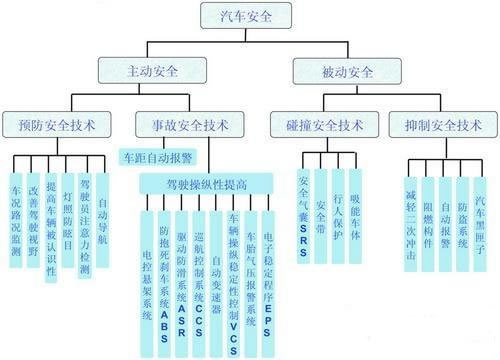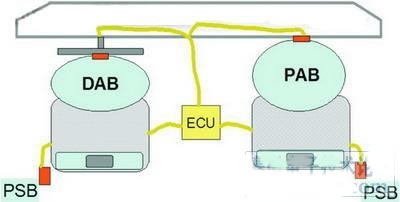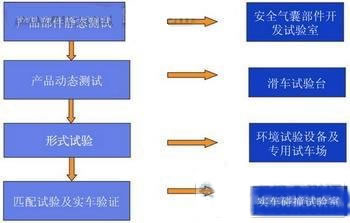Automotive airbag technology and its development trend
Automotive safety systems are the fastest growing segment of automotive electronics. The safety design of automobiles is also increasing in the proportion of vehicle design. Car safety is divided into active safety and passive safety. The active safety system aims to improve the stability of the vehicle and prevent accidents. Passive safety systems begin to function after an accident to mitigate the severity of the accident.
This article refers to the address: http://
Car safety covers a lot of content, and Figure 1 shows the classification of car safety.

Car airbags are passive safety systems. In 2000, China implemented CMVDR 294 "Design Rules for Frontal Impact Occupant Protection", which is equivalent to the European ECE R94 regulations. Recently, China's side collision regulations have been implemented, which will put forward higher requirements for the collision safety performance of our vehicles and the protection system for drivers and passengers. The continuous improvement of the automobile safety regulations system will drive the development of the Chinese automotive electronics market. It is predicted that the installation rate of side airbags for passengers in 2009 will be twice that of 2006, and the installation rate of side curtains will be four times that of 2006. A comparison of the two airbag systems in the United States and Europe is shown in Table 1.
Airbag technology application
The airbag system belongs to the auxiliary restraint system (SRS). Its role is to make up for wearing the seat belt during the collision and still can not protect the occupant's head.
Defects in the face, chest and knees. The composition of the airbag system is shown in Figure 2.
![]()
Figure 2: Airbag system composition
The early airbags were mechanical airbag systems. At present, airbag manufacturers at home and abroad mainly use electronic airbag systems. The basic airbag system includes the driver, the occupant front protection airbag and the seat belt pretensioning device.
The electronic airbag system is characterized by the sensor sensing the movement of the vehicle. The MCU monitors and makes a judgment to determine whether the current event is a serious collision event. If it is a serious collision event, the airbag is deployed to protect the safety of the driver and passenger. The airbag action process is as follows: within 0~20ms after the collision occurs, the sensor sends the signal to the central electronic controller (ECU). After the ECU judges, it is confirmed that it is a serious collision and the gas generator is triggered. The high temperature and high pressure gas (nitrogen gas within 20~60ms) After filtering and cooling into the air bag, the air bag is opened to form an air cushion, and the occupant is separated from the vehicle equipment. After 60~100ms, the air bag vent hole is opened, and the air bag is deflated and contracted. The damping of the gas absorbs the energy of the collision, alleviating the pressure on the occupant's head and face by the airbag, and the occupant sinks into the softer airbag, so that the occupant is protected. Finally, the gas is completely discharged from the vent hole, and the air bag is squatted. Figure 3 shows the basic loading form of the airbag system. In the figure, the DAB is the driver's airbag, the PAB is the passenger airbag, and the PSB is the seat belt pretensioning device.

Figure 3: Loading form of the basic airbag system
Since the airbag system is a safety component of an automobile, the electronic components used by it have high special performance requirements, and require high precision, good reliability, and strong anti-interference ability.
The electronic control system of the conventional airbag includes an acceleration sensor and an MCU. At present, airbag sensors commonly used by airbag manufacturers at home and abroad are microelectromechanical systems (MEMS) sensors. MEMS sensors have a wide sensing range and can sense accelerations from 1G to 100G. The sensing direction can be from uniaxial to triaxial, on the front. The side, vertical and vertical directions sense the acceleration change during the collision of the car and output an analog signal.
Airbag control requires strong MCU computing power and sufficient I/O port. From the perspective of reliability, it is necessary to use an automotive-grade MCU with some special function modules. MCUs used in accordance with different system performance requirements are 8-bit and 16-bit. For more complex systems, many airbag system suppliers have adopted 32-bit high-performance MCUs.
Airbag system development
The development of airbags is an intelligent system with a large content, with long cycle, large amount of test and high cost. The whole process includes parts development, system development, system vehicle engineering matching, parameter matching and many other tasks. Involved in chemical, mechanical, electronic and other technologies.
The key point in the development of the airbag system is the airbag ignition control algorithm and the determination of the target ignition timing.
To determine the target ignition timing, first of all, how to evaluate the occupant's injury. Because the airbag is inevitably collided with the occupant, it will cause the occupant's injury, quantitatively analyze the occupant's injury index, and then analyze the airbag's protection against the occupant at different times. effect.
Vehicle passive safety evaluation indicators are determined based on the results of human bioengineering research. The implementation standards are the European standard ECE R94, the US standard FMVSS208, the Chinese regulation is CMVD R294, and the Japanese generally refers to the American standard.
The main damage evaluation indicators are: occupant head injury index HIC, chest displacement ThPC, leg injury force FPC. China's regulations stipulate that the head injury index HIC<1000, chest displacement ThPC<75mm, and leg injury force FPC<10kN after collision.
The target ignition control strategy for the airbag system requires accurate ignition, prevention of mis-points, leaks and late points. At present, the international automotive industry generally adopts the 5in-30ms criterion as the ignition control criterion. The meaning is that during the collision of the car, the first 30ms of the occupant moving forward 5in is the airbag target ignition timing.
According to this criterion, the algorithms for implementing the ignition control strategy of the airbag system include acceleration method, speed reduction method, specific power method, moving window type integration method, etc., which use various combinations of acceleration signals to obtain judgment results and determine the best. Ignition moment. The airbag ignition control strategy algorithm model can be regarded as a nonlinear mapping value F, yi=F(xi) from a multi-dimensional European space to a one-dimensional European space, where x and y are input and output vectors. The output value of the ignition timing is determined by the weight arrangement and equivalent prediction of the input information, and the threshold comparison.
The airbag development process requires specialized equipment and laboratory sites with a specific development process, as shown in Figure 4.

Figure 4: Airbag system development process
The development trend of car airbags
With the development of science and technology and people's attention to the safety of automobiles, the airbag technology in automobile safety technology has also developed rapidly in recent years. Intelligent and multi-airbags are the inevitable trend of the development of the overall airbag system in the future.
New technologies can better identify passenger types and take different protective measures. The system uses weight, infrared, ultrasonic and other sensors to determine the distance between the passenger and the instrument panel, weight, height and other factors, and then judge whether to burst the airbag during the collision, use the first-class ignition or multi-stage ignition, how big the point explosion force, and The seat belt forms an overall control. Through the sensor, the airbag system can also determine the form of collision that the vehicle is currently experiencing, whether it is a frontal collision or an angular collision, a side collision or a tumbling motion of the whole vehicle, so as to drive the airbags at different positions of the vehicle body to form the best protection for the passengers.
The application of network technology is also the development direction of airbag systems. In the automotive network, there is a narrower application, but the very important network is Safe-By-Wire. Safe-By-Wire is a bus specifically designed for automotive airbag systems. Safe-By-Wire technology is designed to achieve subtle control of the airbag system by combining multiple sensors and controllers. The Safe-By-Wire Plus bus standard is proposed by automotive electronics suppliers and component suppliers such as Philips and Delphi. Compared with the CAN, FlexRay and other buses commonly used in vehicle systems, Safe-By-Wire has the advantage that it is a standard for automotive LAN interfaces for airbag systems. In order to ensure that the system is not damaged in the event of a car accident, multiple protection functions are embedded in Safe-By-Wire. For example, even if the line is short-circuited, the airbag system will not start due to an error. Safe-By-Wire technology will find wide application in automotive airbag systems.
Dongguan Fangbei Electronic Co.,Ltd , https://www.connectorfb.com